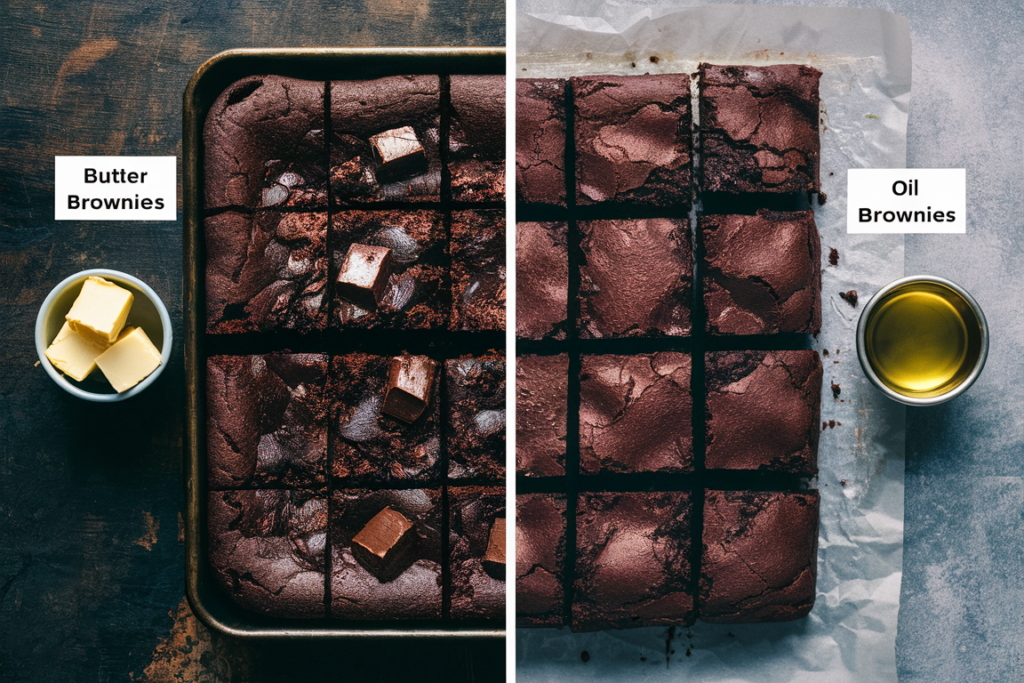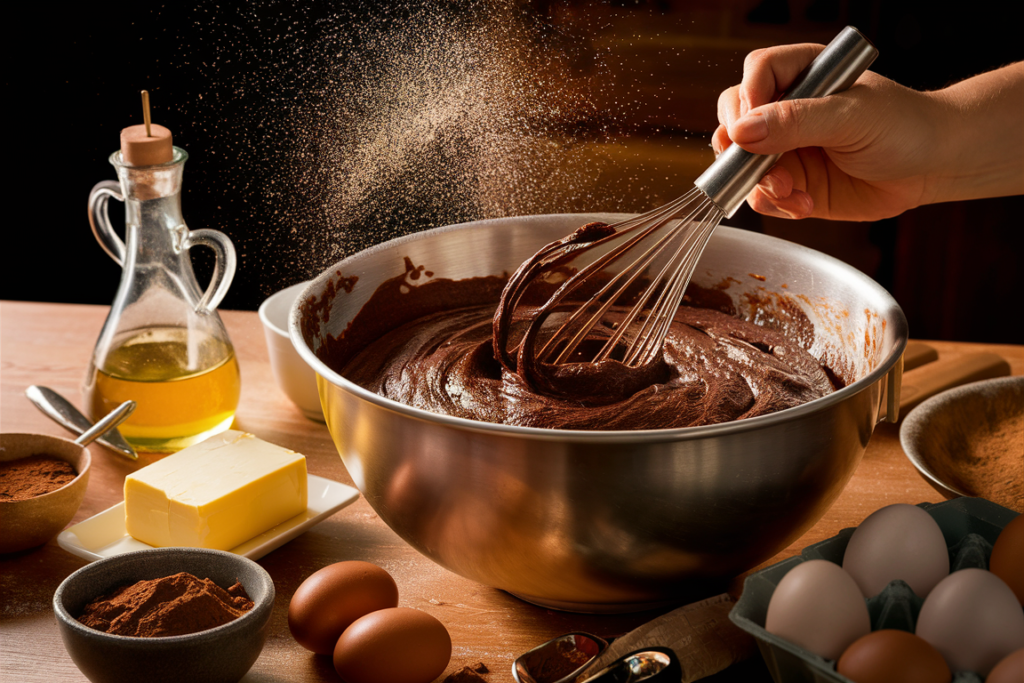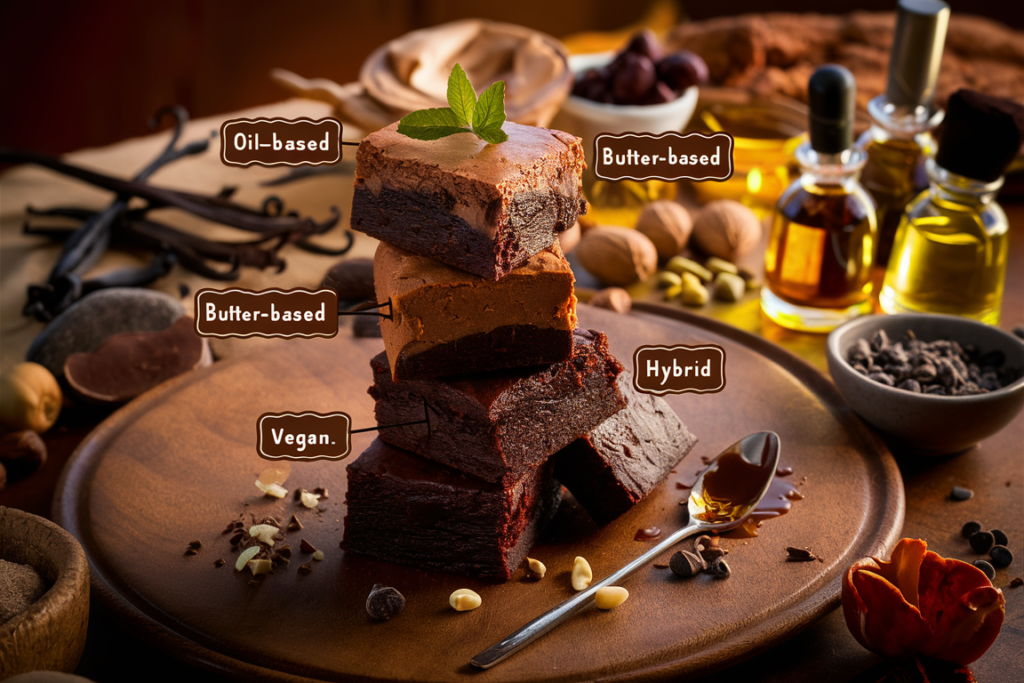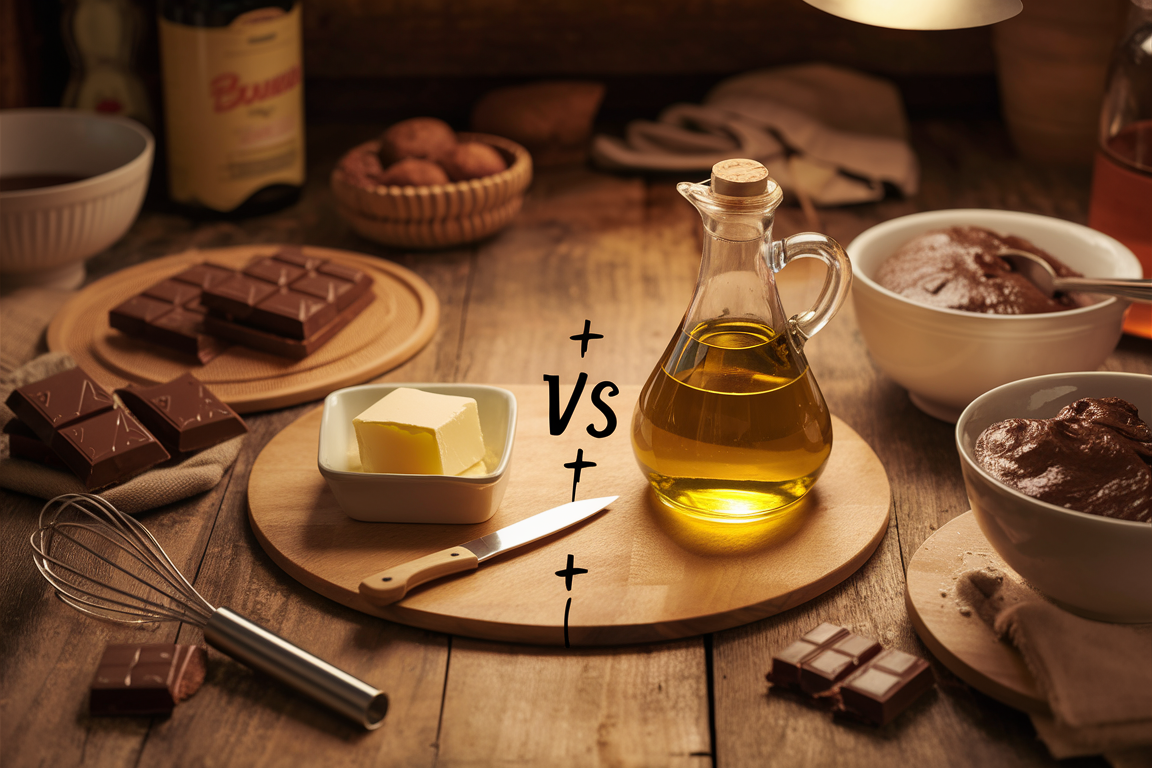Part 1: Exploring the Core Ingredients: Oil vs. Butter in Brownies
Introduction
Brownies are one of the most beloved desserts worldwide, and the choice of fat—oil or butter—plays a crucial role in their flavor, texture, and overall appeal. While some bakers swear by the richness of butter, others prefer the moistness offered by oil. Understanding how these two fats impact the final product can help you decide which ingredient aligns with your taste and dietary preferences.
In this article, we’ll explore the science, flavor profiles, and practical uses of oil and butter in brownies, offering insights into how each can shape your baking results. Let’s unravel the delicious details.

The Role of Fat in Baking
Fat is essential in baking because it contributes to:
- Texture: It helps create a tender crumb by coating flour particles, preventing excessive gluten formation.
- Flavor: Butter especially adds a depth of flavor, while oil remains neutral, allowing other ingredients to shine.
- Moisture: Fat locks in moisture, keeping baked goods from becoming dry or crumbly.
In brownies, the type of fat can define whether your dessert is fudgy, chewy, or cakey. Each fat type interacts uniquely with other ingredients, making its selection an important decision.
Characteristics of Oil-Based Brownies
Brownies made with oil are often celebrated for their moist texture and neutral flavor profile. Key characteristics include:
- Moistness: Oil is a liquid fat, and its molecular structure traps moisture more effectively than butter, resulting in brownies that stay soft longer.
- Lightness: Without the solid fat of butter, oil brownies tend to feel less dense and heavy.
- Flavor Neutrality: Vegetable oils like canola or sunflower allow other ingredients, like chocolate or vanilla, to take center stage.
While oil brownies are undeniably moist, some may miss the depth of flavor that butter provides.
Characteristics of Butter-Based Brownies
Butter brings an indulgent richness to brownies. Its key traits include:
- Enhanced Flavor: Butter’s natural flavor enhances the taste of chocolate, creating a more luxurious experience.
- Dense Crumb: Solid at room temperature, butter gives brownies a firmer structure, making them ideal for those who love dense, fudgy textures.
- Caramelized Notes: During baking, butter can add subtle caramel flavors, elevating the overall taste.
However, butter-based brownies may dry out faster compared to their oil-based counterparts.
Scientific Breakdown: How Fat Types Affect Brownie Chemistry
From a scientific perspective, the difference lies in how the fats interact with other ingredients:
- Oil: Being 100% fat, oil doesn’t contain water. This lack of water means there’s less gluten development, leading to softer, moister brownies.
- Butter: Butter is about 80% fat and 20% water. The water can activate gluten in flour, contributing to a denser structure.
Each fat type also influences the melting and emulsifying processes, directly impacting texture and mouthfeel.
Common Oils Used in Brownies
Choosing the right oil can make a significant difference in flavor. Here are some popular options:
- Vegetable Oil: Neutral in flavor and widely available, this is a classic choice for brownies.
- Coconut Oil: Adds a subtle coconut aroma and richness, ideal for tropical-inspired brownies.
- Olive Oil: Offers a unique, slightly fruity flavor, perfect for gourmet recipes.
Experimenting with oils can help you discover exciting flavor combinations.
Types of Butter for Brownies
Butter offers versatility with its various forms:
- Unsalted Butter: The preferred choice for baking as it gives you full control over the salt level.
- Salted Butter: Adds a touch of saltiness that can complement sweet flavors in brownies.
- Clarified Butter (Ghee): With the water content removed, it offers a nuttier flavor and longer shelf life.
Choosing the right type of butter can further enhance your brownie’s texture and taste.
Health Considerations of Oil vs. Butter
When considering health, it’s essential to evaluate the nutritional aspects of each fat:
- Butter: High in saturated fat and cholesterol, it may contribute to heart health concerns if consumed in excess.
- Oil: Depending on the type, oils like canola and olive contain healthier unsaturated fats, making them a better choice for those watching their cholesterol levels.
While oil may be the healthier option, butter’s flavor might outweigh these considerations for some.
Vegan and Dairy-Free Options
For those following a vegan or dairy-free diet, oil becomes an indispensable substitute for butter. Popular choices include:
- Coconut Oil: A favorite for vegan recipes due to its richness and solid-state similarity to butter.
- Vegetable Oil: A reliable, neutral-flavored alternative.
Replacing butter with oil ensures that dietary restrictions don’t compromise taste or texture.
Cultural Variations in Brownie Recipes
Globally, different traditions influence whether oil or butter is preferred in brownies:
- American Recipes: Often favor butter for its indulgent flavor.
- Middle Eastern Recipes: Frequently use oil, particularly olive or sunflower oil, for their availability and moisture-retaining qualities.
- Asian Recipes: Lean towards neutral oils like vegetable or rice bran oil for a lighter texture.
These cultural nuances add a fascinating dimension to the oil-versus-butter debate.
Part 2: Practical Baking Insights: Deciding Between Oil and Butter
Flavor Profiles: Oil vs. Butter
The flavor profile of brownies is deeply influenced by the type of fat you use. While butter delivers a rich and creamy taste, oil takes a back seat, letting other ingredients shine.
- Butter-Based Brownies: The natural flavor of butter enhances the chocolate’s depth, often adding a slight caramelized undertone during baking. This makes butter the preferred choice for those who love a more indulgent and layered flavor.
- Oil-Based Brownies: Oil, especially neutral ones like canola or sunflower, does not compete with other flavors. This is ideal if you want the chocolate or any added ingredients, like nuts or fruits, to dominate the palate.
Some recipes experiment with flavored oils like olive oil, creating unique twists on traditional brownies.

Textural Differences in Brownies
The texture of brownies varies significantly depending on whether you use oil or butter.
- Oil-Based Brownies:
- Known for their soft, moist crumb.
- Tend to be more elastic and chewy.
- Great for recipes aiming for a fudgy texture.
- Butter-Based Brownies:
- Denser and slightly firmer due to butter’s solid-state structure.
- Ideal for creating brownies with a more cakey or structured crumb.
When texture matters most, consider the type of experience you want to deliver: gooey and chewy or dense and decadent.
Moisture Levels: Oil vs. Butter
Moisture retention is another critical factor that separates oil and butter brownies. Oil, as a pure fat, lacks water and binds moisture more effectively, resulting in brownies that stay soft for longer periods.
- Oil Brownies: Stay moist even days after baking, making them ideal for long-term storage.
- Butter Brownies: Can dry out faster due to their water content, but freshly baked, they boast unmatched richness.
If you’re planning to store brownies for several days, oil might be the better choice to maintain freshness.
Cost Efficiency in Baking
From an economic perspective, the choice of fat also impacts your wallet.
- Butter: Generally more expensive due to its dairy origin and shorter shelf life.
- Oil: Affordable and widely available, making it a practical choice for large batches or budget-friendly baking.
For professional bakers or those cooking in bulk, oil’s cost efficiency is hard to beat.
Ease of Use: Melted Butter vs. Oil
When it comes to convenience, oil has an edge:
- Oil: Requires no preparation; simply measure and mix into the batter.
- Butter: Needs to be melted or softened before use, adding an extra step.
However, melted butter provides a creamier mixture, which can enhance batter consistency. While oil saves time, butter offers an experience that might be worth the effort for some bakers.
Adapting Recipes for Oil or Butter
Switching between oil and butter in recipes is easier than it seems. Here’s a simple guide:
- Conversion Ratios:
- Replace butter with oil in a 1:1 ratio by volume (e.g., 1 cup of butter = 1 cup of oil).
- Keep in mind that oil yields a slightly thinner batter.
- Flavor Adjustments:
- Add a teaspoon of vanilla or almond extract when using oil to make up for butter’s flavor.
Experimenting with this substitution helps customize your brownies to specific preferences or dietary needs.
Testing the Ratio of Oil and Butter in Hybrid Recipes
For the best of both worlds, consider using both oil and butter. This hybrid method balances:
- Oil’s Moisture-Retaining Properties
- Butter’s Rich Flavor and Dense Texture
Start with a ratio of 50:50 and adjust based on your texture and taste preferences. Hybrid brownies often deliver the perfect balance of fudgy yet structured.
Expert Opinions on Fat Choices
Professional bakers often weigh in on the debate:
- Chefs Favoring Butter: Highlight its unparalleled ability to enrich flavors and create decadent desserts.
- Chefs Favoring Oil: Praise its moisture-retaining qualities and convenience, particularly for large-scale baking.
Many agree that the ultimate choice depends on the desired outcome, with both fats offering unique advantages.
Choosing Based on Dietary Preferences
Tailoring brownies to specific diets can dictate the type of fat used:
- Keto or Paleo Diets: Coconut oil is a favorite for its compatibility with these low-carb lifestyles.
- Vegan Diets: Oil is the go-to choice, replacing dairy-based butter.
- Gluten-Free Recipes: Both fats work well, but oil ensures a moist and non-crumbly texture.
Understanding your dietary goals ensures your brownies align with personal or audience needs.
Storing Brownies: Oil vs. Butter Variants
Storage plays a vital role in maintaining brownie quality. Depending on the fat used, storage techniques may vary:
- Oil-Based Brownies: Can be stored at room temperature for 3–5 days and retain their moistness longer.
- Butter-Based Brownies: Best stored in an airtight container to prevent drying out; refrigeration is recommended for prolonged freshness.
Proper storage ensures your brownies remain delicious, regardless of the fat choice.
Part 3 : Experimentation and Recipes for Perfect Brownies

Classic Oil-Based Brownie Recipe
Oil-based brownies are celebrated for their unmatched moistness and simplicity. Here’s a classic recipe to try:
Ingredients:
- 1 cup all-purpose flour
- ¾ cup cocoa powder
- ½ tsp salt
- 1 cup granulated sugar
- 1 cup vegetable oil (or coconut oil for a subtle flavor twist)
- 2 large eggs
- 1 tsp vanilla extract
- ½ cup chocolate chips (optional)
Instructions:
- Preheat your oven to 350°F (175°C) and line an 8×8-inch pan with parchment paper.
- In a bowl, mix flour, cocoa powder, and salt.
- In another bowl, whisk sugar, oil, eggs, and vanilla until smooth.
- Combine the wet and dry ingredients, then fold in chocolate chips.
- Pour the batter into the prepared pan and bake for 25–30 minutes, or until a toothpick comes out with a few moist crumbs.
These brownies are perfect for longer storage as they stay soft and chewy for days.
Classic Butter-Based Brownie Recipe
For those who prefer a decadent richness, butter-based brownies are unbeatable.
Ingredients:
- 1 cup unsalted butter, melted
- 1 cup granulated sugar
- 1 cup brown sugar
- ¾ cup cocoa powder
- 1 tsp salt
- 3 large eggs
- 1 tsp vanilla extract
- 1 cup all-purpose flour
Instructions:
- Preheat your oven to 350°F (175°C) and grease a 9×9-inch pan.
- Melt butter and mix it with granulated and brown sugar until smooth.
- Stir in cocoa powder and salt, followed by eggs and vanilla.
- Gently fold in the flour, being careful not to overmix.
- Pour the batter into the pan and bake for 30–35 minutes.
These brownies offer a dense, fudgy texture with a buttery aroma that’s irresistible.
Testing the Same Recipe with Oil and Butter
For a fun experiment, try making the same recipe twice—once with oil and once with butter—to compare:
Observations to Note:
- Texture: Assess the chewiness versus density.
- Flavor: Determine if the richness of butter outweighs the subtlety of oil.
- Moisture: Observe which brownies stay fresher longer.
This side-by-side test can help identify your personal preference.
Infused Oils for Brownies
Elevate your brownie game by using flavored oils. Popular choices include:
- Olive Oil: Adds a fruity complexity, perfect for pairing with dark chocolate.
- Hazelnut or Walnut Oil: Enhances nutty flavors in the batter.
- Chili-Infused Oil: For a bold, spicy kick that pairs surprisingly well with chocolate.
Substitute ½ cup of infused oil in place of regular oil for an elevated twist on the classic recipe.
Brownies with Clarified Butter (Ghee)
Clarified butter, or ghee, brings a nutty depth and longer shelf life to brownies. Here’s a simple recipe:
Ingredients:
- ½ cup ghee
- 1 cup sugar
- 2 large eggs
- ¾ cup cocoa powder
- ½ cup all-purpose flour
- 1 tsp vanilla extract
Instructions:
- Melt the ghee and combine it with sugar, eggs, and vanilla.
- Stir in cocoa powder and flour.
- Bake at 350°F (175°C) for 25–30 minutes.
The result? A richer brownie with subtle caramel undertones.
Vegan Brownies Using Oil
For dairy-free brownies, oil is the perfect substitute. This vegan recipe uses simple pantry staples:
Ingredients:
- 1 cup flour
- ½ cup cocoa powder
- 1 tsp baking soda
- ½ tsp salt
- 1 cup sugar
- ½ cup vegetable oil
- 1 cup almond milk
- 1 tsp vanilla extract
Instructions:
- Mix the dry ingredients in one bowl and the wet in another.
- Combine both mixtures until smooth.
- Bake at 350°F (175°C) for 20–25 minutes.
These brownies are moist, chewy, and completely dairy-free.
Healthier Brownies with Oil Substitutes
Looking for a lighter treat? Replace oil with:
- Applesauce: For added natural sweetness and reduced fat.
- Greek Yogurt: Provides creaminess and a protein boost.
- Mashed Avocado: Adds richness without the extra calories.
Use a 1:1 substitution ratio and experiment to find your preferred flavor balance.
Specialty Brownies: Oil for Spiced and Savory Variations
Oil’s neutral flavor allows for creative twists. Try these ideas:
- Chili-Spiked Brownies: Add ½ tsp cayenne pepper for a fiery touch.
- Savory Brownies: Incorporate a pinch of sea salt and smoked paprika for a unique flavor.
- Spiced Brownies: Mix in cinnamon, nutmeg, or cardamom for warmth.
These variations showcase how oil can amplify adventurous recipes.
Using Compound Butters in Brownies
Compound butters infused with flavors like vanilla, cinnamon, or even coffee can elevate butter-based brownies. Simply replace regular butter with compound butter for a subtle twist.
How to Make Vanilla Compound Butter:
- Mix 1 cup softened butter with 1 tbsp vanilla extract and 2 tbsp powdered sugar.
- Chill until firm and use as a direct substitute for butter in recipes.
This technique adds layers of flavor without extra ingredients in the batter.
Feedback and Preferences: Sharing Your Brownie Success
Once you’ve mastered your recipe, share your brownies with friends and family. Gather feedback on:
- Texture: Do they prefer chewy or dense brownies?
- Flavor: Does the richness of butter or the neutrality of oil win?
- Moisture: Which stays fresher longer?
Incorporating opinions helps refine your technique and ensures every batch is crowd-pleasing.
More FAQs
1. Can I mix oil and butter in brownies?
Yes, combining both can offer the best of both worlds—moistness and flavor.
2. What oil is best for brownies?
Neutral oils like vegetable or canola are preferred, but coconut oil works well for added flavor.
3. How do I make fudgier brownies?
Use oil, reduce flour slightly, and avoid overbaking.
4. Can I use salted butter in brownies?
Yes, but reduce the added salt in the recipe.
5. What’s a good butter substitute for vegans?
Coconut oil or margarine works well.
6. Can I add coffee to brownie recipes?
Absolutely! A tablespoon of instant coffee enhances chocolate flavor.
7. Why are my brownies dry?
Overbaking or using too little fat can result in dryness.
8. Should I refrigerate brownies?
Only if storing for more than a few days; otherwise, room temperature is fine.
9. What flour works best for brownies?
All-purpose flour is ideal, but almond flour can be used for gluten-free recipes.
10. How can I enhance chocolate flavor?
Add a pinch of salt and use high-quality cocoa powder.

